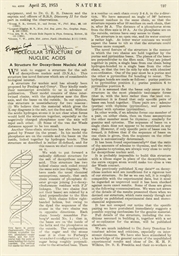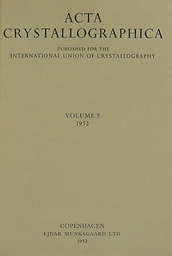CRICK, Francis H.C. (1916-2004) and WATSON, James D. (b.1928). Galley proof signed ("Francis Crick" and "James D. Watson") with two annotations. "Molecular structure of nucleic acids: A structure for deoxyribose nucleic acid." Nature 171 (1953): 737-738. One galley page, 570 x 153mm (repaired at fold, old pin holes to upper margin, a little creasing). "We wish to suggest a structure for the salt of deoxyribose nucleic acid (D.N.A.). This structure has novel features which are of considerable biological interest." Signed galley proofs for the paper that revolutionized biochemistry and the life sciences: the only known prepublication copy of Watson & Crick's momentous 1953 paper. First published in the 25 April 1953 issue of the journal Nature and running around 1000 words, their paper presented the scientific community with an elegant solution to the question of the structure of DNA: the double helix. DNA research had begun in the second half of the nineteenth-century with its identification as a distinct molecule in 1869 by Friedrich Miescher. In 1944 Oswald Avery, Maclyn McCarty, and Colin MacLeod published a paper showing how genes are composed of DNA, and Erwin Chargaff would observe that DNA contained equal amounts of adenine to thymine and of cytosine to guanine. But no one knew what it looked like or how it was copied. In the 1950s, Rosalind Franklin, at King's College London, was using X-ray diffraction to understand the molecular structure of DNA. When a crystallized form of a molecule is exposed to X-rays, the X-rays defract to form a pattern that scientists can use to study the structure. Linus Pauling had made advances in modeling and recently proposed that DNA was a three-stranded helix, but in May 1952, Franklin and PhD student Raymond Gosling produced what came to be known as "Photo 51," showing a distinct X-shape pattern. Maurice Wilkins, also at King's College, shared Photo 51 with Crick and Watson at Cambridge soon after. Watson and Crick's paper correctly identifying the structure of DNA was a watershed moment, a discovery that would fundamentally explain how genetic material could be encoded and replicated. It was published in the 25 April 1953 issue of Nature alongside papers by Franklin and Wilkins, respectively "Molecular configuration in sodium thymonucleate" and "Molecular structure of deoxypentose nucleic acids," and would be followed a mere five weeks later with an equally important further exploration of the copying mechanism for genetic material (see next lot). Franklin died in 1958, but in 1962 Watson, Crick, and Wilkins would receive the Nobel Prize "for their discoveries concerning the molecular structure of nucleic acids and its significance for information transfer in living material." The present proof is the earliest typeset version of Watson and Crick's text, and the only galleys which are extant. It bears an emendation to a footnote, correcting a journal title, which change was corrected in the published version. The "voluminous and unsorted" archives of the journal Nature were thrown out during a move to new offices in 1953, "thus there was nothing available when Macmillan, the publishing company which owns Nature , sold its own archive to the British Library in 1966" (Maddox, Rosalind Franklin, The Dark Lady of DNA , 211). A previous owner of this and the following lot suggests that they both derive from the collection of Linus Pauling (1901-1994). Watson and Crick's reference in their first full paragraph to obtaining Pauling and Corey's recent paper on a structure for nucleic acid—"They kindly made their manuscript available to us in advance of publication"—gives a clue as to how Pauling, perhaps, came to possess the present galleys. Pauling's lab at Caltech was the only one apart from the Cambridge and King's College labs in the U.K. to be competing in the race to determine the structure of DNA. Garrison-Morton 256.3.
CRICK, Francis H.C. (1916-2004) and WATSON, James D. (b.1928). Galley proof signed ("Francis Crick" and "James D. Watson") with two annotations. "Molecular structure of nucleic acids: A structure for deoxyribose nucleic acid." Nature 171 (1953): 737-738. One galley page, 570 x 153mm (repaired at fold, old pin holes to upper margin, a little creasing). "We wish to suggest a structure for the salt of deoxyribose nucleic acid (D.N.A.). This structure has novel features which are of considerable biological interest." Signed galley proofs for the paper that revolutionized biochemistry and the life sciences: the only known prepublication copy of Watson & Crick's momentous 1953 paper. First published in the 25 April 1953 issue of the journal Nature and running around 1000 words, their paper presented the scientific community with an elegant solution to the question of the structure of DNA: the double helix. DNA research had begun in the second half of the nineteenth-century with its identification as a distinct molecule in 1869 by Friedrich Miescher. In 1944 Oswald Avery, Maclyn McCarty, and Colin MacLeod published a paper showing how genes are composed of DNA, and Erwin Chargaff would observe that DNA contained equal amounts of adenine to thymine and of cytosine to guanine. But no one knew what it looked like or how it was copied. In the 1950s, Rosalind Franklin, at King's College London, was using X-ray diffraction to understand the molecular structure of DNA. When a crystallized form of a molecule is exposed to X-rays, the X-rays defract to form a pattern that scientists can use to study the structure. Linus Pauling had made advances in modeling and recently proposed that DNA was a three-stranded helix, but in May 1952, Franklin and PhD student Raymond Gosling produced what came to be known as "Photo 51," showing a distinct X-shape pattern. Maurice Wilkins, also at King's College, shared Photo 51 with Crick and Watson at Cambridge soon after. Watson and Crick's paper correctly identifying the structure of DNA was a watershed moment, a discovery that would fundamentally explain how genetic material could be encoded and replicated. It was published in the 25 April 1953 issue of Nature alongside papers by Franklin and Wilkins, respectively "Molecular configuration in sodium thymonucleate" and "Molecular structure of deoxypentose nucleic acids," and would be followed a mere five weeks later with an equally important further exploration of the copying mechanism for genetic material (see next lot). Franklin died in 1958, but in 1962 Watson, Crick, and Wilkins would receive the Nobel Prize "for their discoveries concerning the molecular structure of nucleic acids and its significance for information transfer in living material." The present proof is the earliest typeset version of Watson and Crick's text, and the only galleys which are extant. It bears an emendation to a footnote, correcting a journal title, which change was corrected in the published version. The "voluminous and unsorted" archives of the journal Nature were thrown out during a move to new offices in 1953, "thus there was nothing available when Macmillan, the publishing company which owns Nature , sold its own archive to the British Library in 1966" (Maddox, Rosalind Franklin, The Dark Lady of DNA , 211). A previous owner of this and the following lot suggests that they both derive from the collection of Linus Pauling (1901-1994). Watson and Crick's reference in their first full paragraph to obtaining Pauling and Corey's recent paper on a structure for nucleic acid—"They kindly made their manuscript available to us in advance of publication"—gives a clue as to how Pauling, perhaps, came to possess the present galleys. Pauling's lab at Caltech was the only one apart from the Cambridge and King's College labs in the U.K. to be competing in the race to determine the structure of DNA. Garrison-Morton 256.3.
.jpg)


.jpg)











Try LotSearch and its premium features for 7 days - without any costs!
Be notified automatically about new items in upcoming auctions.
Create an alert